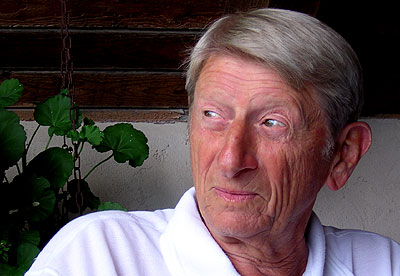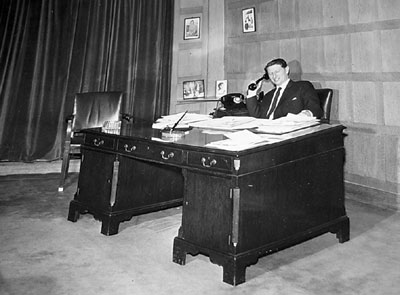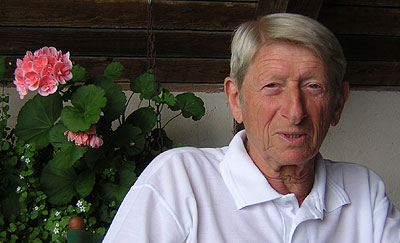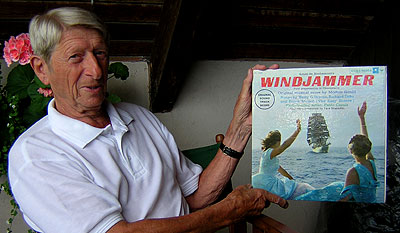Sam Lomberg, MBE
|
Read more
at in70mm.com The 70mm Newsletter |
| Written by: Sam Lomberg and interviewed by: Thomas Hauerslev | Date: 4. January 2005 |
 Sam
Lomberg 12 August 2004. Image by Thomas Hauerslev Sam
Lomberg 12 August 2004. Image by Thomas HauerslevSam Lomberg was born [1920, ed] and raised in London in an area fondly known as Fitzrovia. A cosmopolitan area populated by many well-known artists, actors and musicians. His father was a costume designer consequently right from his childhood he was surrounded by film and theatre folk, so it is no wonder that Sam loved both films and the theatre and that from a very early age he became interested in acting. He was particularly fond of Shakespeare and joined an amateur dramatic society. At the age of twelve he participated in a Shakespearian Festival playing the part of Puck in “A Midsummer Night’s Dream” Sam’s father had plans for him to be a stockbroker, which he considered was safer than the theatre or films. When Sam was due to leave high school his father arranged for him to attend the Stock Exchange College and also secured a job for him with a well-known stockbroker. Sam had other ideas – he wanted to be in the film business. Without saying anything to his father, he applied for a job with MGM and got it. Fortunately for Sam his father was a very understanding man and made no objections. Possibly he was proud of Sam for taking the initiative. At that time (1936) MGM was the largest and most important film company in the world. Sam started his career in the studio publicity department. He was later transferred to sales where he remained until war broke out in 1939. |
Further
in 70mm reading: Kinopalæet Internet link: Sam Lomberg on iMDB Mikael Salomon on iMDB "South of Tana River" Radionyt |
 Sam
Lomberg behind his desk at Columbia. Image from Sam's collection Sam
Lomberg behind his desk at Columbia. Image from Sam's collectionAfter 6½ years in the RAF, Sam returned to MGM and after a brief training period became manager of the London office. In 1949 he was “head-hunted” by Columbia Pictures where he held various executive positions and finally became head of Screen Gems, Columbia’s TV subsidiary. In 1959 he accepted an offer to join NTA as their Director of Foreign Sales. It was while he was with NTA that he became involved with Cinemiracle and the road showing of “Windjammer”. Although he had spent more time on sales and distribution than on production, Sam’s main interest had always been production. Purely by coincidence he met Henning Karmark, head of ASA Films in Denmark, at a cocktail party in London. This meeting resulted in Henning Karmark asking Sam to join ASA who wanted to get into international production instead of producing films solely for the Danish market. After visiting Denmark and seeing the studio as well as ASA’s distribution set up, Sam felt that not alone was this an opportunity to get really involved with production but that the low costs, lack of union interference and a general enthusiasm could make Denmark very attractive for English and/or American independent producers as well as for co-productions. Although his friends and business connections in England thought he was crazy, Sam had never been afraid to take a chance, furthermore he was convinced that he could make a go of it so he went ahead and signed a three-year contract with Henning Karmark and moved to Denmark. And now I will leave the rest of the story to Sam. |
|
 Sam
Lomberg 12 August 2004. Image by Thomas Hauerslev Sam
Lomberg 12 August 2004. Image by Thomas HauerslevProduction-wise my three years with ASA were very disappointing. Despite the fact that Karmark had previously said he was very interested in getting into international production, each time I came up with a proposition for a co-production – and mostly with very well known English or American producers or companies – Karmark turned it down because he was planning another Danish film. Karmark had a great liking for going on safari in East Africa so one day I sat down and wrote a screenplay for an action film to be shot in East Africa. Of course I intended this to be an international co-production and had already spoken to Henry Geddes an English producer who had previously produced films in East Africa. He liked the idea and said he would use his top cameraman Johnny Coquillon who had always been with him in Africa. Karmark also liked the idea possibly mostly because he would be able to spend time in East Africa and also go on safari, but he was not prepared to make it an international production -it would have to be purely Danish with Danish actors. However he thought it would be a good idea to ask Henry Geddes and Johnny Coquillon to participate because of their knowledge of East Africa and in particular in shooting a film in which animals were involved. I asked Finn Holten Hansen to write the script and he did a very good job of it. And so off we went to Nairobi. Whenever my family or friends want to annoy me they start talking about “That film you made in East Africa” ["Syd for Tana River"/"South of Tana River", ed]. Karmark made alterations to the script, cut out sequences with wild animals and in general screwed-up the film. We could just as well have shot it in Denmark. I hated it then and still do. That was my last attempt to interest Karmark in international productions. But my time with ASA was by no means a total loss. Among other things I knew the studios and had met many of the technicians among them a young cameraman Mikael Salomon who I felt had a great deal of talent and who I used on most of my productions. While working for me Mikael met several American producers and eventually decided to go to Hollywood where he is now a well known cameraman and producer. |
|
 Sam
Lomberg 12 August 2004. Image by Thomas Hauerslev Sam
Lomberg 12 August 2004. Image by Thomas HauerslevAlso due to my previous connections with Cinemiracle, Cinerama who had taken over Cinemiracle, approached me about the possibility of representing them and finding cinemas that could be adapted to run the three-projector system. Due to my contract with ASA I was unable to do this on my own but after discussing it with Henning Karmark I told Cinerama I could help but that ASA would have to be involved. Cinerama agreed to this. I then set about finding a suitable cinema in Copenhagen. Cinerama were interested in the Imperial but we found that design-wise it was not suitable. The next obvious choice was the Kinopalæet – not only was the size and shape right, it was owned by Lau Lauritzen with whom ASA were closely connected. Finally the reconstruction was completed and we were ready for the premiere of the first film, "Seven Wonders of the World". It was all very exciting but mostly we kept our fingers crossed that the three projectors would run in sync. However all went well and the premiere was a success. The first programmes were travel films, which did reasonably well, but although "How The West Was Won" did good business the following films were not a success. I think Cinerama should have stuck to travel or adventure films. By this time my contract with Karmark had come to an end. I saw no point in renewing it; in fact I had already made up my mind to set up my own distribution and production company. My feeling that I could convince English and American companies to shoot films in Denmark proved to be correct. In the first years we did films for Columbia, Paramount, Shaw Brothers of Hong Kong, Roman Polanski and Walter Shenson. Among the many English and American actors involved were Geraldine Chaplin, Jack Warden, Britt Ekland and Oliver Reed (whom I disliked intensely). But of course the film that meant most to me was my own production of “King Lear”. I didn’t make any money on it but working with Peter Brook and such actors as Paul Scofield, Irene Worth, Jackie McGowran, Cyril Cusack was the most exciting experience of my life in the film business. And remember I have loved Shakespeare since the age of twelve! |
|
|
Go: back
- top -
back issues
- news index Updated 21-01-24 |
|
